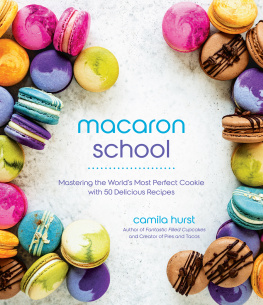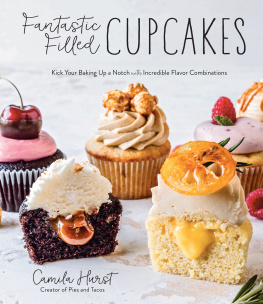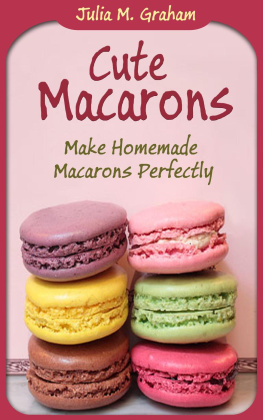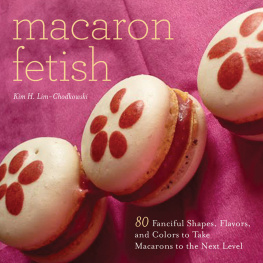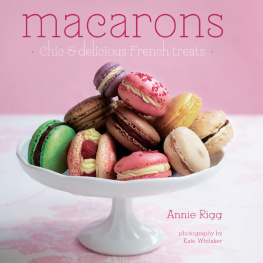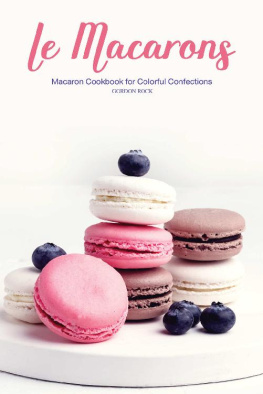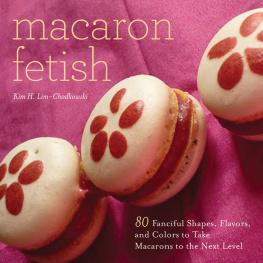macaron
school
Mastering the Worlds Most Perfect Cookie
with 50 Delicious Recipes
camila hurst
Author of Fantastic Filled Cupcakes
and Creator of Pies and Tacos

The author and publisher have provided this e-book to you for your personal use only. You may not make this e-book publicly available in any way. Copyright infringement is against the law. If you believe the copy of this e-book you are reading infringes on the authors copyright, please notify the publisher at: http://us.macmillanusa.com/piracy.
I dedicate this book to my son, Luke!
Welcome to your personal macaron school! This is a book that Ive wanted to write for a really long time. I fell in love with macarons a few years ago. In the beginning, I loved their taste, the endless flavor possibilities and the fact that you can decorate them in so many different ways, shapes and colors. Macarons are like a blank canvas. Sharing them on my blog and social media, and connecting with bakers all over the world, has shifted my passion from just making them to also teaching about them in depth as I continue to explore and learn all there is to know about these incredible treats.
The thing about macarons is that they are not like regular cookies and cakes, where you can mostly achieve good results by following a decent recipe step by step. Making macarons is an art of its own. Its like learning how to draw; someone can tell you how to hold the pencil, recommend the best tools and teach you about perspective and proportions, but once you actually start drawing yourself, you will find that its going to take a lot of practice to get to where you want to be. And most importantly, you will have to figure out your style.
The whole secret to making macarons is just that: finding out what works best for you by equipping yourself with as much knowledge as possible through videos, blogs, books and macaron teachers on Instagram and then, most importantly, putting things into practice and trying them for yourself. When it comes to making macarons, so much can change depending on the weather, the altitude of where you live, the oven you use, the tools you have at your disposal and the brands of ingredients you selectthe list goes on and on!
That being said, the challenging aspect of making macarons is what really attracts me and so many others to this craft! Its an art that requires dedication, a great deal of passion, the ability to start over and try again even after one (or ten) epic fails.
.
The more you inform yourself, and the more knowledge you are able to acquire, the better your chances are at succeeding at making macarons. This book is intended to be a very valuable tool, amongst others, that you should consult to help improve your macaron gamenot to mention all of the exciting flavors and amazing filling recipes you will find in these pages! The flavor combo possibilities are infinite, and I am delighted to be sharing some very special and exclusive recipes with you.

There are different methods you can use when making macarons: French, Italian and Swiss. In this book I will focus on the Swiss method.
The French method consists of whipping egg whites with cream of tartar until foamy, and then adding granulated sugar and continuing to whip until the resulting meringue achieves stiff peaks. After that, almond flour and powdered sugar are folded into the meringue to make the batter. While the French method is straightforward and possibly simpler than the Italian and Swiss, it doesnt result in the most stable meringue out of the three methods, which makes it more prone to deflating, breaking or getting overwhipped.
The Italian method is the one with the most steps. It requires heating up a water and sugar syrup to the soft-ball stage while whipping the egg whites to stiff peaks. Then, as soon as the syrup reaches 240F (116C), its whipped in with the egg whites until the meringue cools down and stiff peaks are achieved. A paste of almond flour, powdered sugar and egg whites is folded in to make the batter. This is by far the most high-maintenance method, but it makes a very stable meringue and beautiful shiny shells.
And now weve arrived at the happy medium: the Swiss methodmy favorite! It yields a meringue that is more stable than the French method but doesnt involve as many steps or take as much time to make as the Italian, which is why I recommend it for beginners. In the Swiss methodwhich we will cover in detail in this bookegg whites and sugar get heated over a double boiler just until the sugar melts, then the syrup is whipped to stiff peaks and folded with almond flour and powdered sugar in the process called macaronage.
The reason Swiss meringue is more stable than the French version has to do with the introduction of heat to the process. Dissolving the egg whites and sugar together helps the denaturation process. Denaturation is the unfrilling of the proteins in the egg whites during whipping, which is what forms the stiff peaks and makes the meringue fluffy. Furthermore, the process of melting the sugar increases the viscosity of the syrup that coats the air bubbles in the meringue, contributing to an even stronger meringue structure.

Perfectly whipped meringue
The best way to master macarons is to understand the three main stages of making the batter: the meringue stage, the macaronage and the oven. Once you understand exactly what the meringue is supposed to look like, the perfect stage of the macaronage and how to best use your oven, things will become much easier.
first, lets discuss the meringue: The meringue should be whipped to stiff peaks. The peaks should be shooting straight up, not bending down to the side. To identify this stage, keep an eye on the meringue as it whips. If the meringue starts to become fluffy around the whisk, you can start checking your peaks. Youll know you are getting close to this stage when the meringue is balling up around the whisk and looks glossy.

Underwhipped meringue
Dip the whisk in the bowl with the meringue and swirl it around to grab a good amount of meringue, then hold it upright. You only need a peak that measures 2 to 3 inches (5 to 8 cm); if the peak is any longer than that, it will probably bend down, giving you the impression that the meringue isnt whipped enough.
If the peak is shooting up without bending to the side, and if the meringue around the base of the whisk has a nice soft and fluffy cloud-like formation, it is probably done.

